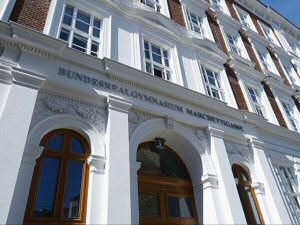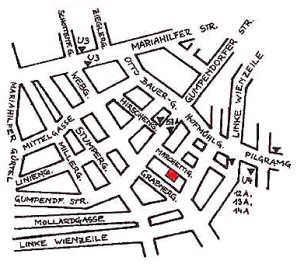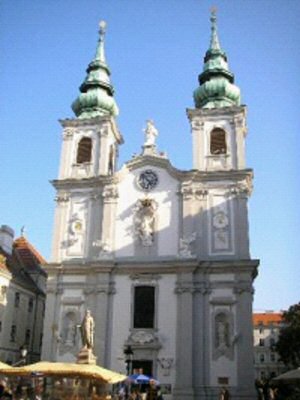 |
 |
Name
MA²ThE-TE-AMO
MAking MAThEmatics TEAchers MObile
Code
129543-CP-1-2006-1 -IT-COMENIUS-C21
Action/type
COMENIUS-C21
Project span
01.10.2006
01.10.2009 |
|
 |
 |
| |
 |
|
 |
 |
 |
Austrian participating school and Mathematics topics

School “BRG Marchettigasse”BRG VI “Marchettigasse”
Marchettigasse 3
1060 Wien
Austria Public transport: U3, U4, 12A, 13A, 14A, 57A
tel: (+43) 1 597 65 38
fax: (+43) 1 597 65 38 – 16
email: rg6@906016.ssr-wien.gv.at
homepage: http://www.marchettigasse.at
Principal: HR Mag. Walter Holub
This year the students are taught from 45 teachers in 18 classes in the age group of 10-18 years (first to eighth grade). If the parents choose so, the students are also cared for in the afternoon when regular classes have finished. For this service the parents have to pay extra. The amount is determined by the city of Vienna and not by the school itself. Since the school year 1999/2000 the BRG VI “Marchettigasse” is open to the students five days a week (Monday to Friday).
Foreign languages that are offered include
- English (beginning in the first grade)
- French or Latin (beginning in the fifth grade)
- Spanish or Italian as one of the several subjects that the students have to choose in their sixth to eighth grade.
Optional subjects include additional biology and chemistry classes, and music classes like guitar and piano.
Further optional subjects – where the students are not graded – include choir, theatre, orchestra, volleyball.
Special offers to the students are:
- Projects in foreign countries
- Support of gifted students in sciences, arts and sports
- ECDL (European computer driver’s license)
- Partnership programs between first and seventh grade
- “Learning learning”
- Support of students with dyslexia
The continuous development of the school and measures for quality improvement are important aims for the principal and the teachers. Pedagogical conferences and pedagogical days are devoted to these topics.
Mathematics teaching
There are seven math teachers at the school. They are responsible for up to 27 students per class and teach mathematics for four lessons (= 4 x 50 minutes) a week in first, second, third, fifth and sixth grade and three lessons a week in fourth, seventh and eighth grade.
Surrounding of the school
LocationThe school is located in “Mariahilf”, Vienna’s 6th district, southwest of the city center. “Mariahilfer Straße”, Vienna's most important shopping street, is the north border to “Neubau” (=7th district), in the south there is “Wienfluss”, in the west the “Gürtel”.It consists of the five neighborhoods (historical “Vorstädte” i.e. towns): Mariahilf, Gumpendorf, Windmühle, Magdalenengrund and Laimgrube.

HistoryFirst settlements around the Roman roads of the area developed around the year 1000. In 1428, the name Im Schöff is mentioned for the first time, but this name was lost when the copy of a sacral painting from Passau was installed in a chapel of the graveyard, which came to be known as Mariahilf ("Mary's help").
More intensive settlement started only after the Second Turkish Siege of Vienna in 1683. The area was of some importance because the road to Schönbrunn Palace led through it.
Gumpendorf was mentioned in 1130 for the first time and developed from a Roman watchtower. It was subject to various feudal lords and was sold to the municipality of Vienna in 1798.
Magdalenengrund originally consisted only of vineyards. In 1698, some plots were released for construction.
The Laimgrube (clay pit) is probably the oldest part of Mariahilf. It was mentioned in 1291 for the first time, but has existed already since the 11th century. Its name is derived from the clay soil, which was used to produce bricks.
Windmühle (windmill) developed from a feudal holding used by various monastic orders. In 1529 it was destroyed during the First Turkish Siege. Emperor Ferdinand I had the ownership transferred to Johann Francolin, subject to the condition that he should build windmills there. However, he had only built one windmill.
On March 6, 1850, the five Vorstädte of Gumpendorf, Mariahilf, Windmühle, Magdalenengrund and Laimgrube became part of Vienna as the Fifth District, Mariahilf. When “Wieden” was split into two districts in 1861, it became the 6th district. In 1862, some areas north of Mariahilfer Straße were ceded to the 7th district (Neubau).
“Dark secrets” about the school surrounding
Due to renovations in 2005, skeletons were found at the area of the schoolyard, buried 3 meters below the ground. The area was part of an almost unknown military graveyard founded at the end of the 18th century. For further information please follow the link http://www.fotos-geschichten.at/skelette.htm (also in english).
EducationBeside some buildings of the Vienna University of Technology, Mariahilf hosts the Franz Schubert Conservatory and the central vocational schools for electrical engineering, information technology, metallurgy, glass-ceramic, sanitary engineering, heating engineering and air conditioning technology.
Celebrities associated with Mariahilf
- Joseph Haydn
- Ferdinand Raimund
- Michael Thonet
- Siegfried Marcus
- Oskar Werner
Sights
- Arik Brauer House
- Mariahilf Fire station
- Gustav Adolf Church
- Flak towers and Aquarium
- Raimundtheater
- Theater an der Wien
- Mariahilf Church
- Gumpendorf Church
- Naschmarkt
- Fillgraderstiege

Mariahilf Church
Mathematical topics
in the period October - December 20086th grade: rules for divisibility, greatest common divisor and lowest common multiple, prime numbers; fractions (+, -, ×, :).
7th grade: whole numbers; (number ray, predecessor and successor, order, calculating with whole numbers), rational numbers.
Textbooks
 Click here to see the Austrian textbook excerpts on Fractions. Click here to see the Austrian textbook excerpts on Fractions.
 Click here to see the Austrian textbook excerpts on Pythagora's Theorem. Click here to see the Austrian textbook excerpts on Pythagora's Theorem.
| |
 |
 |
| |
|
|













